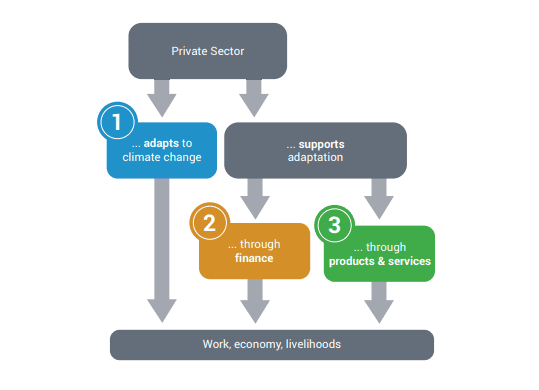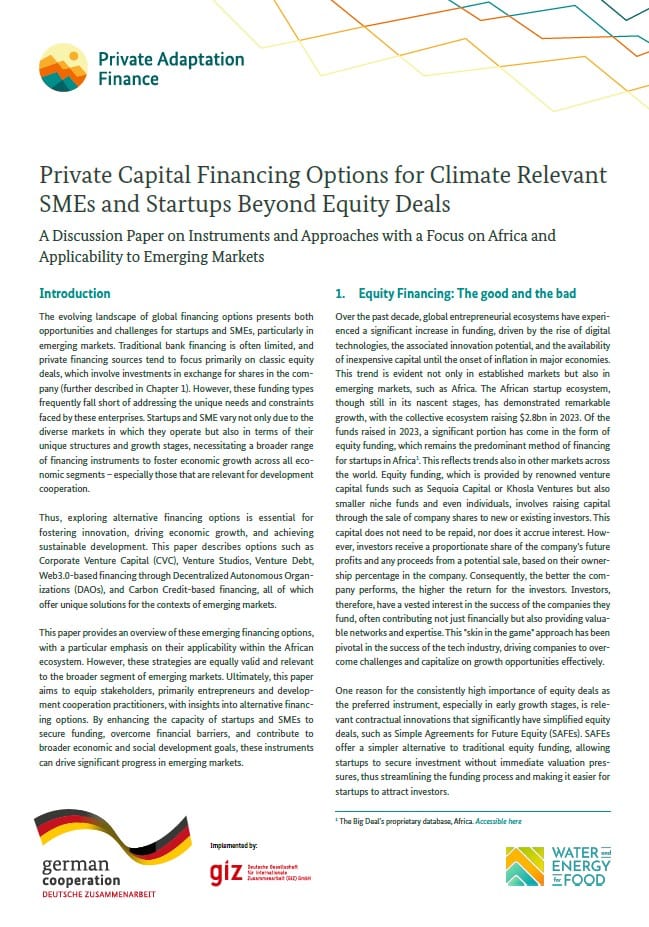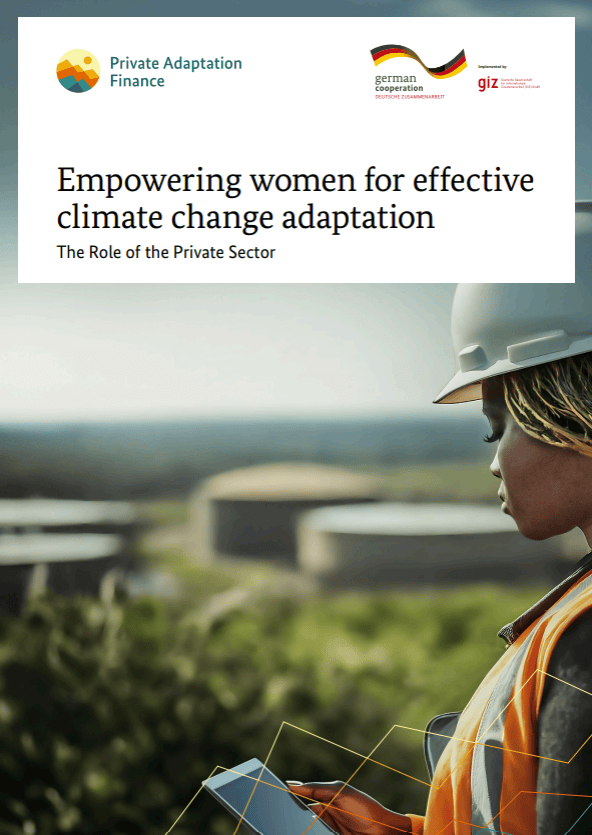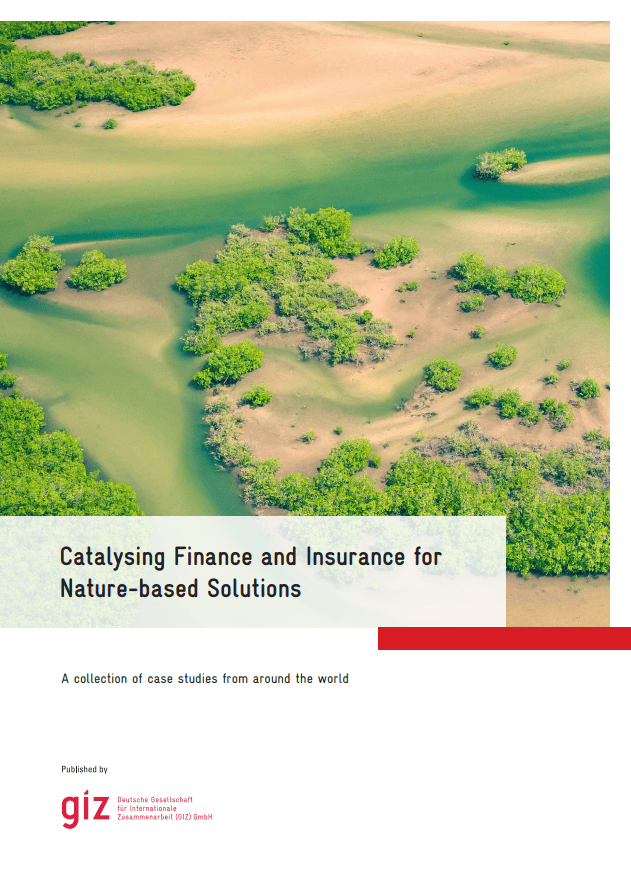Dealing with risks and seizing & financing opportunities in the private sector
Dealing with risks and seizing & financing opportunities in the private sector
The private sector must respond to climate-related economical risks and seize business opportunities to safeguard operations, to strategically create sustainable growth and to increase societal resilience.
The private sector can respond to current and projected climate change induced impacts by

adelphi, 2019. The roles of the private sector in climate change adaptation – an introduction. Available at: https://www.adelphi.de/en/publication/roles-private-sector-climate-change-adaptation-introduction
Role 2 and 3 can also be interpreted as seizing business (and investment) opportunities in climate change adaptation. The following sections explain these roles in more detail.
Climate change has severe effects on the private sector. It is estimated that climate change could add over USD 100 billion of loss each year to the global economy, resulting in indirect costs from supply chain disruption and other knock-on economic consequences4. The first role of the private sector is thus to adapt its own assets, operations, supply chains, and resources to the impacts of climate change to ensure business continuity and sustainable economic growth.
Rising sea levels, temperatures, and more frequent extreme weather events, such as droughts, floods and wildfires and other climate change impacts threat business assets, supply chains and operations more and more frequently. Climate-induced risks vary between sectors and are determined by an enterprise’s direct exposure to those hazards. At the same time, such risks are also determined by their vulnerabilities, which can be can contextually defined as resource dependency.
The private sector consists of various actors, ranging from large multinational enterprises to individual business owners and other non-governmental agencies, who regardless of their size and sector need to adapt to the widely felt impacts of climate change. However, this happens in different degrees and timelines depending on their respective vulnerabilities to direct and indirect climate-induced risks. A company’s size and financial resources are important factors for determining their capacity to adapt to climate change. Besides, limited resources pose further challenges for private sector adaptation as they prevent investing in adaptation measures to counter extreme weather occurrences and slow-onset events. Such resource limitations inter alia include a lack of awareness of climate and disaster risks, as well as limitations to available solutions.
Private sector adaptation to climate change aims to minimize climate-induced risks in order to increase the resilience of businesses and to avoid potential future costs. Managing climate risks thus should be embedded into corporate risk management. By improving their adaptive capacity and by implementing adaptation measures, vulnerability to climate-induced risks and related negative effects on businesses can be reduced.
Companies will first focus on adaptation within their direct sphere of influence. This can include measures to improve company buildings and infrastructure, the production process, the situation of employees or the storage of supplies and produced goods. Collaboration on adaptation with external stakeholders, such as suppliers, buyers, governmental authorities or the financing community is more challenging.
Which adaptation measures a company chooses depends on the climate change impacts and risks it faces. These are dependent on the company’s location, sector, technology level, and adaptive capacity. Deciding factors include investment costs for measures, the type of risk covered, the comprehensiveness of the measure and, whether there are (positive or negative) side effects to be expected.
See the Climate Expert Website for case studies from Bangladesh, Costa Rica, Morocco, Nicaragua and Rwanda
Examples for adaptation measures to minimize risks include:
Climate change adaptation requires a thorough understanding of the potential impacts of climate change and how buildings, operations, (human) resources and the overall strategy of a company are likely to be affected. There are different approaches that can serve companies to assess those risks. Tools usually encompass an exposure assessment to climate-related risks, as well as an assessment of each potential climate hazard’s impact on the company to identify and prioritize possible adaptation measures. By defining several standard impact areas to be analyzed by these tools, such as the company’s buildings, its processes, its logistics and stock, employees, the regulatory framework, access to finance and market demand, these assessments can be implemented in a structured way for each company. Cost-benefit tools or similar decision-making instruments can further support companies’ decision on the most beneficial adaptation measures. Visit our Webpage Climate Risk Assessment & Management for more details.
The second key role of the private sector is to mobilize investments into adaptation solutions, such as innovative technologies, products and services, as well as projects and other measures to close the adaptation finance gap and to accelerate existing solutions to respond to current and oncoming climate risks.
A major challenge toward mobilizing investments into private sector solutions for climate change adaptation is that adaptation business models can often not be identified by capital providers due to both insufficient communication and awareness of the adaptation relevance from solution providers, as well as due to the lack of standardized impact measurements of adaptation solutions. Indeed, metrics to measure and thus compare adaptation impacts have not yet been developed, mainly due to issues, such as geographical dependencies and varying adaptation solutions. Whilst mitigation business models can be measured through the quantifiable metric of ‘CO2 emissions/ton reduced’, adaptation solutions take all kinds of different forms and shapes.
Find in the following link a featured selection of funds that at least partially focus on climate adaptation & resilience.
The specific challenges linked to mobilizing private sector finance for adaptation projects, such as a lack of information on profitable investment opportunities, adaptation hypotheses and impact measurements, requires dedicated technical assistance for both the finance demand and supply side. Scaling adaptation solutions not only requires redirecting financial flows, but must also mobilize additional capital and investments. Next to governmental financial incentives, the private sector can be engaged to invest in adaptation solutions through targeted technical assistance measures to strengthen capacities to identify, scale and finance adaptation investment opportunities where the business case is often less visible than in mitigation solutions. Furthermore, expertise and knowledge of local climate data complements the often too narrowly defined financial lens soley focusing on monetary returns, revenues, and profit by translating climate impacts into business opportunities.
The third role of the private sector is about providing new and scaling up existing adaptation solutions. The demand for innovative technologies, services, and products that support climate change adaptation is growing rapidly.
Examples for exploiting business opportunities
Climate change induced environmental degradation often results in a trickle-down-effect that negatively impacts resource availability, food security, and other existential factors safeguarding the well-being of societies. Due to the interrelation between climate change and socio-economic factors, solutions that can help vulnerable populations to adapt often exhibit mitigation and societal co-benefits. For example, improved irrigation services not only help small-scale farmers adapt to increasingly scarce water resources due to longer periods of drought, but also safeguard farmer’s income and improve food security. Similarly, water filters not only help individuals adapt to increasingly unclean water that pose health risks to their consumers but also reduces the need to boil the water on gas stoves or charcoal, thereby offering mitigation co-benefits. These cross-functional advantages highlight the importance of scaling adaptation solutions and mobilizing investments to fill the adaptation finance gap.



You need to load content from reCAPTCHA to submit the form. Please note that doing so will share data with third-party providers.
More InformationYou need to load content from reCAPTCHA to submit the form. Please note that doing so will share data with third-party providers.
More InformationYou are currently viewing a placeholder content from Google Maps. To access the actual content, click the button below. Please note that doing so will share data with third-party providers.
More InformationYou are currently viewing a placeholder content from Google Maps. To access the actual content, click the button below. Please note that doing so will share data with third-party providers.
More InformationYou are currently viewing a placeholder content from Mapbox. To access the actual content, click the button below. Please note that doing so will share data with third-party providers.
More InformationYou are currently viewing a placeholder content from OpenStreetMap. To access the actual content, click the button below. Please note that doing so will share data with third-party providers.
More Information